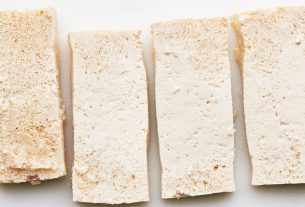I am a yogurt person but when I see it curdled, I tend to dislike it and think twice if I am going to eat it or not. You are probably just like me.
Why does yogurt curdle? When yogurt is exposed to heat or when it is left for quite some time in your fridge, its surface becomes a bit watery while the bottom becomes thicker, this is what we call curdled yogurt.
Do you know that it is safe to eat it? Yes, it may not look appetizing, but it is safe to eat yogurt even when it is curdled. You can simply stir it and it will look like your regular yogurt.
Keep in mind though that curdled yogurt smells like yogurt and though it may not look appetizing it does not smell sour. If you find it smelling sour and looked crumbled after stirring it, then it has turned bad and not anymore good for consumption.
Curdled Yogurt In Cooking
You might like to swirl yogurt in your soup and that could be really tasty, but adding fresh yogurt in a warm dish will make it curdle, your soup may not look appealing to eat but it will still taste better.
So here are a few tips on how you can prevent yogurt from turning into curds if you want it in your warm dishes.
Tips to remember on how to prevent yogurt from curdling when cooking:
- Use whole milk yogurt instead of non-fat yogurt. Whole milk yogurt is full of good fats and these fats also has proteins that prevent it to curd when heated. Non-fat or low-fat yogurt however has less fats and protein thus it is inclined to curd when heated.
- Leave yogurt at room temperature if stored in the fridge before cooking with it or whipping it on your hot meals.
- Add an ample amount of flour or cornstarch to yogurt to thicken and prevent it from curdling. Suggested amount is a teaspoon to a cup of yogurt.
- Mix yogurt with warm water or liquid before putting it to the dish you are cooking. This process is tempering the yogurt which allows it to be lightly warmed and lessens the susceptibility of yogurts to curdle when added to very hot dishes.
- Yogurt will curd when added to sour or acidic food so lessen the amount of lemon or vinegar on food where you want to add yogurt. You can also opt to just serve it separately.
- Do not stir or mix yogurt vigorously while cooking as it may also cause it to curdle.
Curdled Yogurt In The Fridge
When you store yogurt in your fridge for days, it may also curdle because of the cold temperature. Its surface will appear watery but if it does not smell sour and look chunky, then it is still good or safe to eat. It might not appear enticing to you, but it is still healthy.
The watery substance is formed when yogurt curdled because it contains proteins and fats, and this liquid is a whey protein. In this case, you can stir the yogurt until it thickens, and the watery surface is gone but never discard this liquid because it is what makes yogurt healthier.
Whey is a protein in liquid form found in yogurt, and it is what appears watery on the surface when the yogurt curdled. This liquid is also called the acid whey. It is rich 9 amino acids which are considered the complete protein so never filter it away.
This liquid whey also contains lactose and probiotics which gives flavor to the yogurt. It also has calcium, protein, and vitamins that are good for the body. Yogurt is also recommended to those who wants to lose weight due to its low fat and cholesterol content.
Remember that it is typical for any yogurt product to curdle when refrigerated specially if left there for quite some time as it is normal to have that watery surface, so now that you know, never throw it away or you will lose all its health benefits.
However, also remember that though it may curdle and look watery it should smell like milk or yogurt and it will not go chunky when you stir it. If it does go chunky and smells rancid, never eat it and just discard it.
How To Tell If Your Yogurt Has Curdled
You might have kept some yogurt in your refrigerator, and you are anxious to know if it has already curdled.
Fresh yogurt can be stored or refrigerated for weeks to three months if properly sealed. Store packaged yogurt are vacuum sealed and can remain fresh even for six months in the fridge. If you already opened it and then wanted to keep the leftover for storage, be sure to store it in a tightly-sealed food container to prevent air and odors from other refrigerated food from sipping into it to prevent curdling or even spoilage.
Also, yogurt has slightly sour or fermented taste that makes it hard to say when it just curdled or already turned bad.
So, how would you know if you have a curdled yogurt?
Here are some checkpoints to know if you have a curdled yogurt:
- Stir yogurt with a spoon or a stirrer. If you can see tiny round chunks at the edge of the container, it means that your yogurt is curdled.
- When it feels tough stirring the yogurt, it means that is a curdled yogurt. Yogurt is typically creamy and smooth.
- Observe how the yogurt will fall into a container when you spoon it. If it falls like chunks or somewhat watery it has already curdled. Good yogurt will slide smoothly on your spoon to the container.
- Yogurt has a tang but not too sour. You can smell the yogurt and if it smells too rancid then it has already turned bad and better discard it. Curdled yogurt still smells like mild sour milk but not too rancid.
Why Does Yogurt Curdle When Heated
Yogurt contains milk and proteins and when heated proteins in milk fats coagulate which changes the appearance of the yogurt which we call curdled.
Whole milk yogurts contain more fats than low-fat or non-fat yogurt thus low-fat yogurts easily curdle than full-fat or whole milk yogurts when added to hot dishes or when cooked.
Yogurt lovers would choose whole milk yogurt when cooking because it is thicker, tastier, and as it does not curdle much like non-fat yogurts.

Related Questions
Is it a good idea to heat up Greek yogurt?
There is no problem if you want to heat up your Greek yogurt but to avoid curdling, you may temper it before mixing it to a dish at high temperature.
To temper yogurt, you need to mix it with warm water in a bowl before mixing it to the dish you are cooking. Also, add it when the dish is cooked and do not boil it for more than 30 seconds to prevent curdling.
What are health benefits of eating yogurt?
Yogurt is high in calcium, protein, vitamins and probiotics or live good bacteria. It is good for our digestive system and promotes good teeth and bones. It also boosts our over-all immune system and helps prevent yeast infections. Low-fat or Non-fat yogurt is good for those on weight-loss diet.
Is eating yogurt daily bad for health?
Yogurt is good for daily consumption to boost our immune system and regular consumption will increase the positive effects on our health. However, it may not be good for everyone specially to those who are lactose intolerant or to those who have certain allergy on dairy products.
Does heating yogurt kill the bacteria?
Depending on your appetite, you can eat yogurt whether it is cold or hot. Some likes it out of the fridge, and some wants it in their hot dishes.
Yogurt is rich in probiotics or good bacteria for our digestive system and overall health. Prolong exposure to heat may kill the good bacteria in the yogurt thus reducing its health benefits
It is recommended to add yogurt on already cooked food and do not heat or boil it for more than two minutes.
Curdled Yogurt
Do not worry if you see your yogurt curdled when you take it out from the fridge after a few days or after adding it to your hot dishes. It may not be appealing to look at, but it is still safe for you to eat.
Also remember that the watery substance on the surface of the yogurt is a very healthy whey liquid protein and you should not discard it. Simply stir or mix the yogurt and you will see it thickens.
Be cautious though before eating or adding it to your dish by smelling it and looking at it closely. You need to discard it right away if it smells too sour, looks chunky and a bit discolored.


